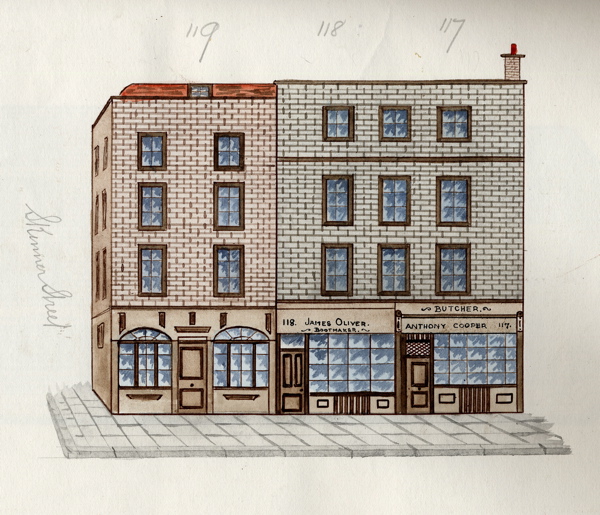Tallis’ Street Views Of Bishopsgate 1838
Site of Bishopsgate Institute

The same location today
Before anyone ever dreamed of Google Street Views, there were Tallis’s London Street Views of the eighteen-thirties “to assist strangers visiting the Metropolis through all its mazes without a guide.” John Tallis created the precedent of a map which included pictures of all the buildings as a visual aid, commissioning the unfortunately-named artist Charles Bigot to do the drawings and writer William Gaspey to create the accompanying text. Tallis had his imitators, evidenced by this beautiful set of anonymous watercolours of every single facade in Bishopsgate, Spitalfields, dated to 1838 and preserved at the Bishopsgate Institute.
There is an obsessive quality to these paintings which drew my attention when I first came upon them, displaying an amateurism in the brushwork and lettering that recalls folk or outsider art. I cannot deny the appeal of recording every facet of the world in this way because there is a strange reassurance to be gained from looking at these neat little pictures. They are reminiscent of the visualisations created for buildings that are yet to be built, in which less salubrious elements are excluded in images designed to endear us to the proposals of architects and developers.
Although these views of Bishopsgate advertise their veracity by recording every single brick, I do not believe it actually looked like this because the buildings are uniformly clean and well maintained. In contrast to the chaotic nature of Google Street Views that record our contemporary cityscapes, there is a comic flatness in these drawings. They are more reminiscent of street scenes in toy theatres and those houses you find on model railway layouts, tempting me to paste them onto matchboxes and create my own personal Bishopsgate. Neat, tidy and eminently respectable, the early nineteenth century society envisioned by these innocuous facades is that of Adam Smith’s “nation of shopkeepers.”
While Bishopsgate itself is unrecognisably altered from the time of these drawings, the proportion of the buildings, providing a shop on the ground floor, with family accommodation and sometimes workshops above, is still familiar in Spitalfields today. The two stocks of brick used, red brick and the London yellow brick remain the predominant colours over one hundred and fifty years later. Sir Paul Pindar’s House, illustrated in the penultimate plate, was the lone survivor from the time before the Fire of London when Spitalfields was a suburb where aristocrats had their country residences. Today the frontage of Sir Paul Pindar’s House can be viewed at the Victoria & Albert Museum where it was moved in 1890.
Named Ermine St by the Romans, for centuries Bishopsgate was the major approach to the City of London from the north leading straight down to London Bridge, and the saddler and harness makers, and coach builders who set up business in the street reflected the nature of this location as a point of arrival and departure. There are some age-old trades recorded in these pictures which survived in Spitalfields until recent times, upholsterers, umbrella makers and leatherworkers, while the straw hat makers, cutlers, dyers, tallow sellers and corn dealers went long ago. Yet we still have plenty of hair dressers today. Let me admit, my favourite business here is Mr Waterworth, the Plumber – who could become a credible addition to a set of Happy Families, along with all his little squirts.
Corner of Houndsditch

Corner of Houndsditch
Corner of Union St, now Brushfield St

Corner of Brushfield St today
Corner of Primrose St

Corner of Primrose St
This space is now occupied by Liverpool St Station and the frontage of Sir Paul Pindar’s House is in the Victoria & Albert Museum

Archive images courtesy Bishopsgate Institute
You may also like to read about
The Romance of Old Bishopsgate



































Lovely. I feel the urge to cut them out and make little streetscapes.
In a word – ‘FASCINATING’! (And belated Happy New Year wishes to our Gentle Author…)
Fascinating as ever. I always start my day by looking at the morning’s blog…Thanks
They are a lot nicer that Google streetscape! Valerie
Ancestor John Robert Overton, working as a Shopman (probably) in Linen Drapers in Bishopsgate Street Without, joined congregation of Little Alie Street Baptist Chapel in 1807 with his (devout) fiancee, Ruth. They married in 1808 at St Dunstan and All Saints, Stepney. Witness was Andrew Kniess a wealthy Sugar Refiner. Ruth died in 1823 and her obituary is in the Baptist Magazine for that year. John Robert’s grandmother, Judith Sollicoffer, who died in 1810 in MEOT, leaving him bequest, also left bequest to miniature painter Charles Hayter and her trustee (second marriage) was Carl Heydinger, a German bookseller who worked as Librarian for the Honourable Henry Cavendish. Sollicoffer was a Spitalfields Dyer when he married Judith in the Fleet!
All those people are so interesting! I’m trying to link it all!